Canon EOS 500D Digital SLR Review
Canon EOS 500D Digital SLR
It's no longer the baby of the Canon DSLR range
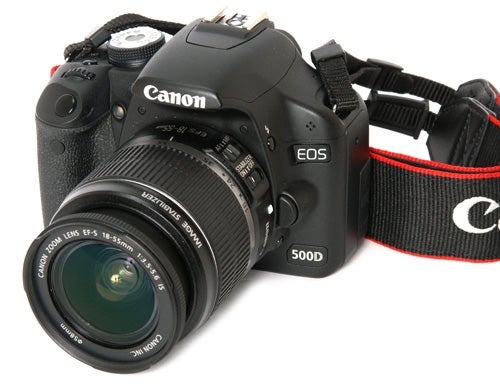
Verdict
Key Specifications
- Review Price: £570.00
Of the five main digital SLR manufacturers, Canon has enjoyed the largest market share for a number of years now. Arch-rival Nikon has never been too far behind though, and has recently added some very strong new models to its range. Relative newcomer Sony is in third place and gaining ground with an even larger range of DSLR cameras including some very impressive new models.
Canon’s tactic in the face of this intensifying competition has been to increase the number of models in its own range, adding additional tiers to the traditional beginner-intermediate-professional hierarchy. With the EOS 1000D (£380) now serving as the entry-level foundation of the range, the older triple-digit series has now been promoted to more of a lower-intermediate role, fitting in between the 1000D and the EOS 50D (£720), while the new EOS 7D (which I’ll be reviewing on Saturday) takes on the flagship role of Canon’s APS-C cameras.
As part of this range-rethink, in March of this year Canon launched the EOS 500D, an upgrade and replacement for last year’s popular EOS 450D. In keeping with its new more advanced hobbyist role the 500D is loaded with features, including 1080p HD video recording, DIGIC 4 processor and the same fast and powerful 15.1-megapixel CMOS sensor as the EOS 50D. It is currently selling for approximately £580 including the basic 18-55mm f/3.5 – 5.6 image stabilised EF-S kit lens.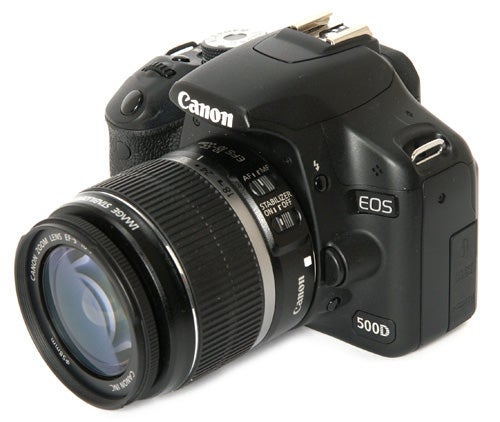
The EOS 450D was a very successful model for Canon, with that single model accounting for around 15 percent of worldwide DSLR sales last year. However the camera market is volatile and highly competitive, and buyers considering an EOS 500D will also be looking at the Nikon D5000 (12.3MP, £515 inc. kit lens), the Sony Alpha A380 (14.2MP, £490 inc. kit lens), the Pentax K-x (12.4MP, £600 inc. kit lens) and the Olympus E-620 (12.3MP, £580 inc. kit lens). They might also consider the Panasonic Lumix DMC-G1 Micro Four-Thirds camera (12.1MP, £455 inc. kit lens). The 500D has more features and a more powerful sensor than any of its immediate rivals, and the price is far from extortionate by comparison. At first glance then the Canon certainly looks like it could be a bit of a bargain, and trust me those are words I never expected to write.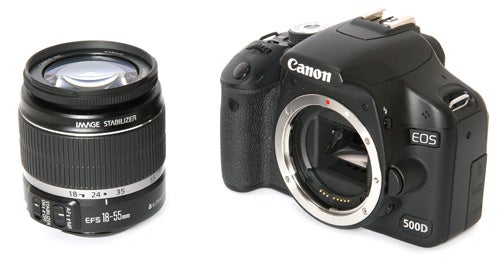
At least externally there’s not much to distinguish the EOS 500D from its predecessor the 450D. The body is identical, a conventionally-styled SLR shape with a comfortable handgrip. The body is made of a strong but lightweight polycarbonate plastic and the build quality is excellent, with no gaps at the body seams. The control layout is also identical to the 450D, with the additional functions added to existing controls. 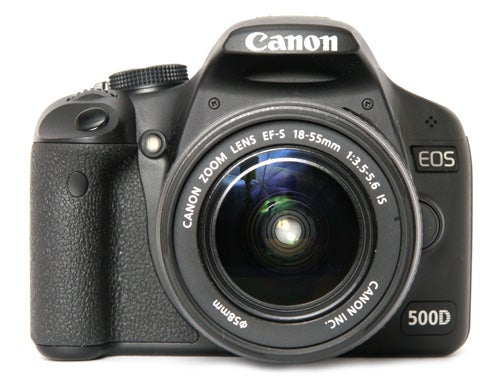
Although the camera doesn’t claim any weatherproof credentials the body and hatches are well protected against dust, and the card slot hatch has a strong metal hinge. I commented in my review of the 450D that the body felt flimsy. This is not something I would say about the 500D, although that may be because I’ve seen more entry-level cameras recently rather than any change in build quality. Although the 500D weighs 5g more than the 450D at 480g that is due to internal changes rather than increased bulk.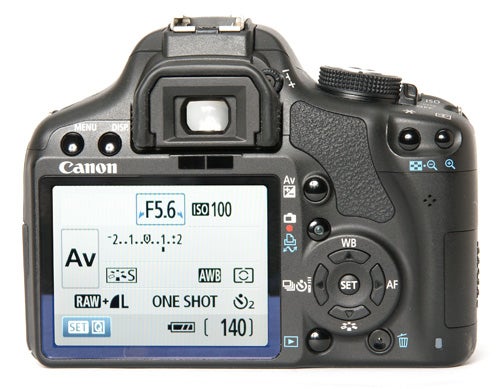
Those internal changes are numerous and extensive. The headline feature is the new sensor, the same powerful high-speed 15.1MP CMOS unit as used in the next model up the range, the semi-pro EOS 50D. The 50D was praised for its excellent image quality especially in low light, so this certainly bodes well for the 500D’s performance. Also borrowed from the 50D is the superb three-inch 920,000 dot monitor and the powerful pop up flash with an ISO 100 guide number of 13.
One of the few components retained from the 450D is the autofocus system. It has nine sensor points, with a central f/2.8 cross type sensor. It’s not a bad system by any means, and operates quickly and accurately even in low indoor lighting, but it does sometimes hunt around a bit in lower light. Compared to the D50’s AF with nine cross-type points, or the 11-point MultiCam AF of the Nikon D5000 it does look a bit limp. The 500D has no AF assist lamp, but if the flash is popped up it will strobe the flash to provide low-light AF assistance.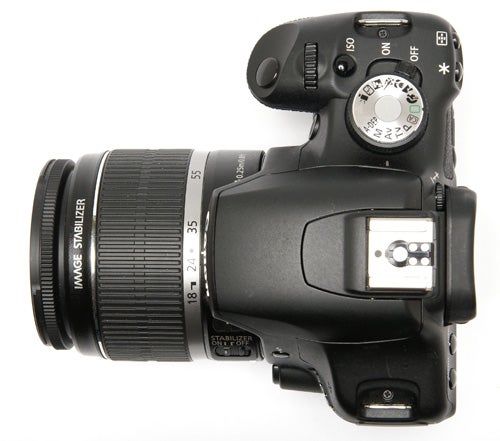
One component that deserves special mention is the viewfinder, which is very large and bright and certainly on of the best in its class. It has a nice bright data display along the bottom, and the nine AF points are indicated by small but bright LED points. The viewfinder has a good wide range of dioptric correction for those of us who wear glasses, and a soft removable rubber cushion. Apparently there is an eyepiece extender available too.
One key new feature, and a major selling point of the EOS 500D, is its HD video recording capability. The 500D was the second camera in Canon’s range to feature HD video, after the success of the 5D Mk II. However while the 500D can indeed record video in full 1920 x 1080 resolution, it can only do so at 20 frames a second, and also only with mono audio through a frankly rather poor internal microphone, so it’s unlikely to have the appeal to serious film makers that has sold so many EOS 5D Mk IIs. The 500D can record video for up to a second shy of 30mins, but a 4GB SD card can only hold 12 minutes and it needs Class 6 high speed cards to work properly. Shooting at the smaller 1280 x 720 resolution and 30fps gives visibly smoother results and 50 percent more shooting time.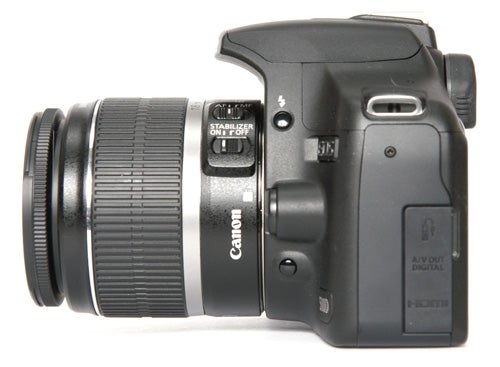
Of course along with the video mode the 500D also has live monitor view. The monitor itself is outstanding, clear and bright with minimal glare or reflection, a viewing angle of close to 180 degrees in every direction, and with a resolution of 920,000 dots it’s as sharp as anything else on the market. Live view is activated by a button on the back of the camera. It’s a useful feature for certain types of photography, particularly for composing studio shots with the camera on a tripod, but the single-zone contrast detection autofocus that is available in live view mode is very slow, so it won’t be much use for action shots.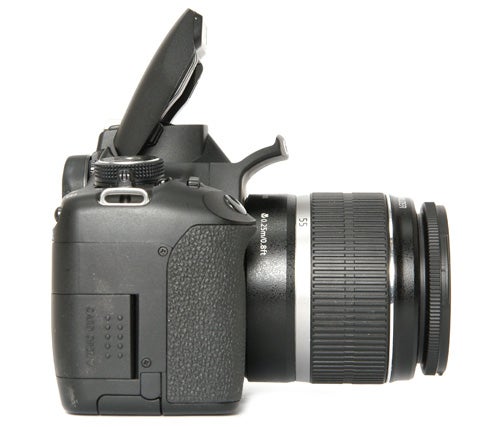
The main processor of the EOS 500D is upgraded to the powerful DIGIC 4, the same as the EOS 50D and 5D Mk II, and with it the 500D has inherited the same excellent menu system. It’s a well designed interface, with a series of non-scrolling pages arranged left to right, so every option is very quick and easy to find. It offers a lot of customisable control, including custom vignetting correction (“peripheral illumination”) when using Canon lenses. It has manually adjustable high ISO and long exposure noise control, as well as options such as mirror lock-up, selectable exposure level increments and ISO range expansion. It is this level of control that sets the EOS 500D apart from many of its more entry-level rivals and indeed from the 450D. While it still has scene modes and a fully automatic option, the 500D feels like a more advanced camera, and has the versatility to match.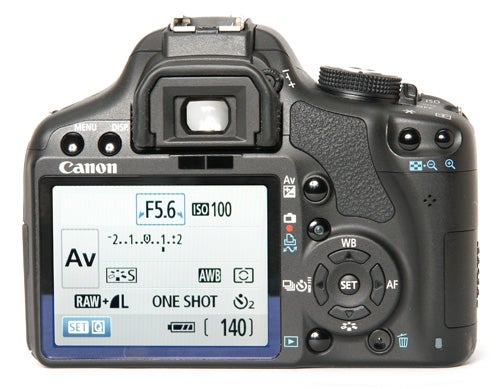
Less experienced users, or just those who prefer a quicker interface, are not forgotten, with a handy quick graphical menu for frequently used shooting and exposure settings. The appearance of this can be customised with half a dozen pre-set colour schemes.
The new DIGIC 4 processor has had a marked effect on some aspects of the camera’s performance. The maximum ISO setting has been upped to 3200, but can be expanded to an impressive 12,800, although it has to be said that the image quality at this setting is not good. Oddly some other aspects of the 500D’s performance are actually slightly slower than its predecessor. It does start up extremely quickly, and is able to take a picture within a fraction of a second of being switched on. In single shot mode it can take a picture just as fast as you can press the button, with virtually zero shutter lag. In continuous shooting mode it also sounds pretty quick at approximately 3.4fps, until you remember that the EOS 450D could shoot at 3.5fps. The 500D does have a larger image buffer though, and can shoot bursts of up to 170 JPEG images, although I found that even using a high speed Class 6 card there was a marked drop off in shooting speed after about 60 frames. In Raw mode it can still manage 3.4fps, but only for 10 frames.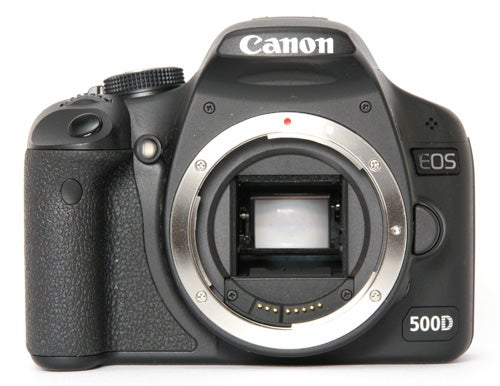
At its best the 500D’s image quality is unquestionably very good, with rich bright colours and lots of fine detail, although if you look at the sample shots on the following pages I think you’ll agree that it doesn’t offer a decisive advantage over rivals such as the Nikon D5000, or indeed over the 450D. The exposure system appears to be the same as the 450D, and suffers from the same slightly erratic performance, under or over exposing by as much as a stop under high contrast conditions.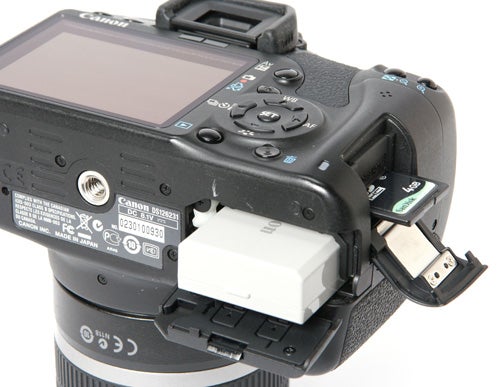
Dynamic range also appears to be slightly more limited than the 450D, with burned out highlights and featureless shadows on a number of high-contrast shots. Unusually shooting in Raw mode and adjusting the exposure in post-processing did little to help in these situations, but then the advanced processor should be expected to do a good job of optimising the JPEG output.
One area where the 500D does excel is image noise control. It’s one of the few APS-sensor cameras to produce reliably usable images at 1600 ISO, although it does show a little chromatic noise even at medium ISO settings. The adjustable noise control can be used to compensate, but it does reduce the detail slightly. Shooting in good conditions at lower ISO settings the 500D is capable of outstanding image quality, possibly matching that of the EOS 50D, which isn’t at all bad for a camera costing under £500.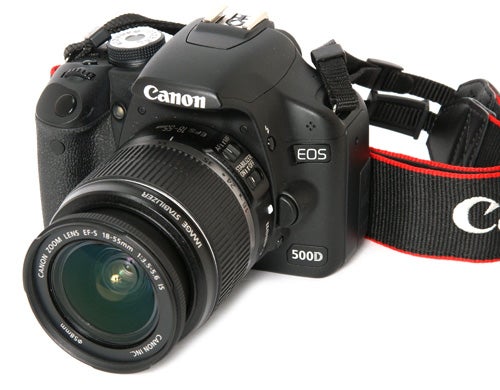
”’Verdict”’
The Canon EOS 500D is a worthy successor to the popular 450D, and adds a number of useful features, including the must-have HD video recording, a more powerful sensor and a nice new monitor. Build quality, handling and performance are as good as ever, and image quality is at least equal to anything in its class. With a good combination of versatility and quality at a decent price it looks like another best-seller.
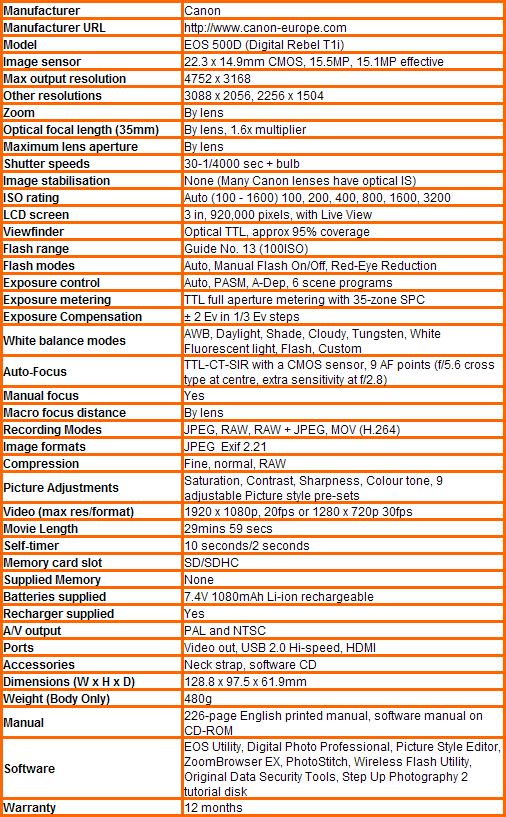
”Over the next few pages we show a range of test shots. On this page the full size image at the minimum and maximum ISO settings have been reduced to let you see the full image, and a series of full resolution crops have taken from original images at a range of ISO settings to show the overall image quality. These pictures were taken indoors using reflected natural light ”
—-
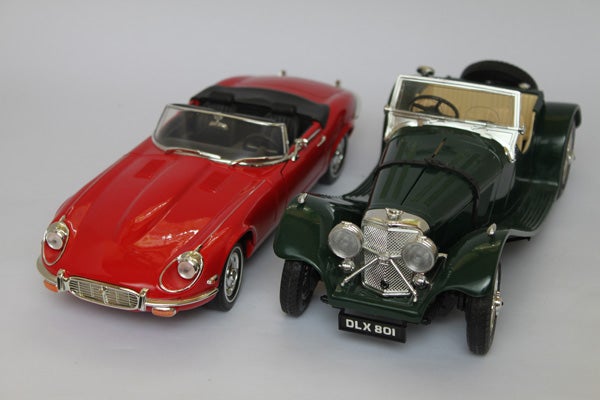
This is the full frame at 100 ISO.
—-
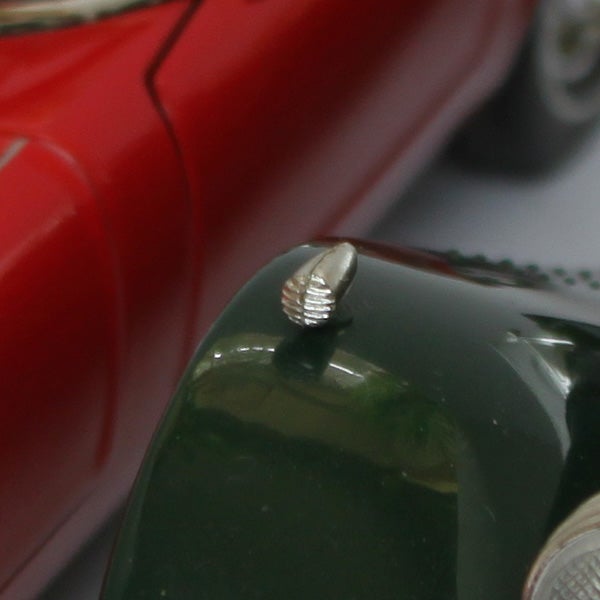
At the minimum ISO setting the image quality is pretty much flawless despite the 1/4-second exposure.
—-
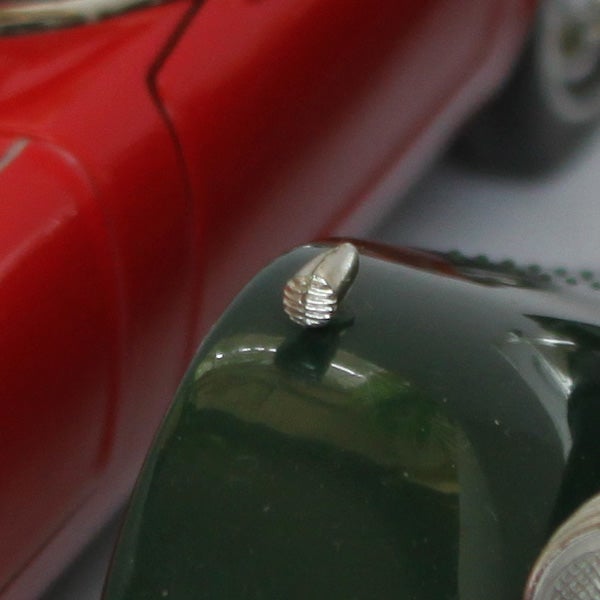
Virtually identical results at 200 ISO.
—-
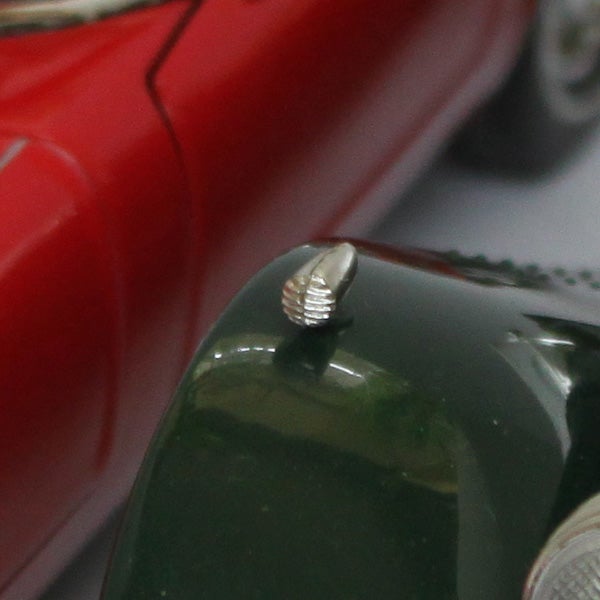
There is a bit of chroma noise in the mid-tone areas at 400 ISO, but it’s nothing serious.
—-
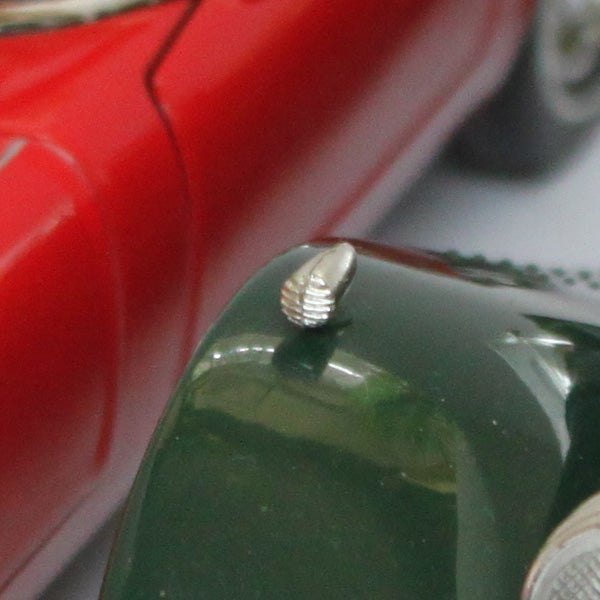
Much the same at 800 ISO.
—-
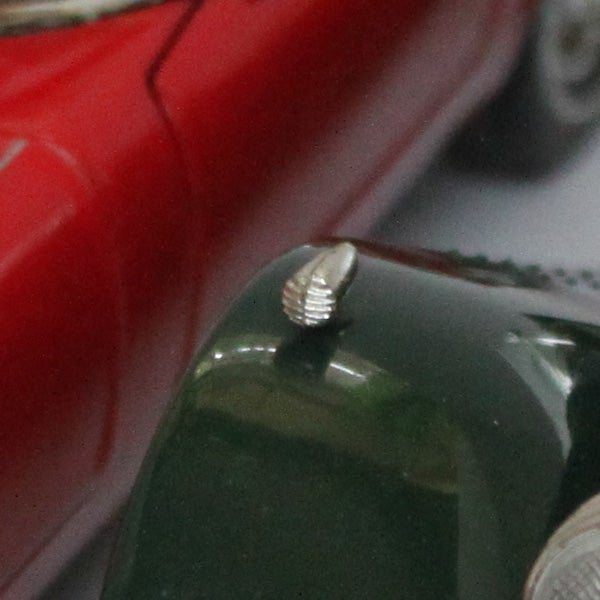
The image quality is quite printable at 1600 ISO, which is about what you need for good indoor no-flash photography.
—-
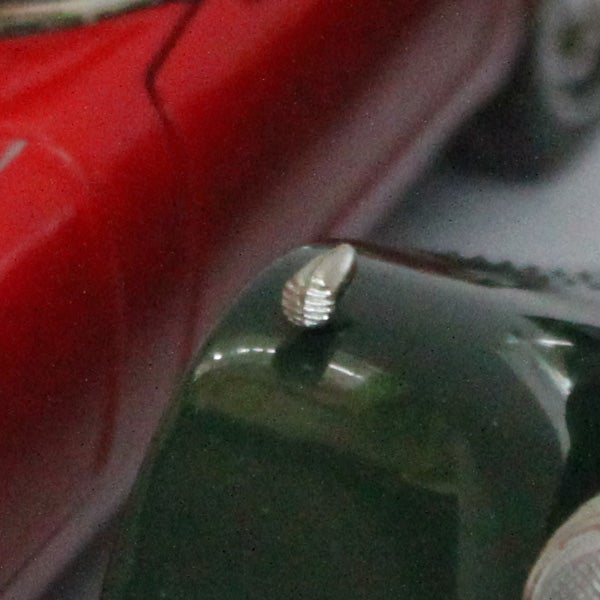
3200 ISO is getting a bit noisy, but it’s not completely unusable.
—-
”A range of general test shots are shown over the next two pages. In some cases, the full size image has been reduced for bandwidth purposes, and a crop taken from the original full resolution image has been placed below it to show the overall image quality. Some other pictures may be clicked to view the original full-size image. ”
—-
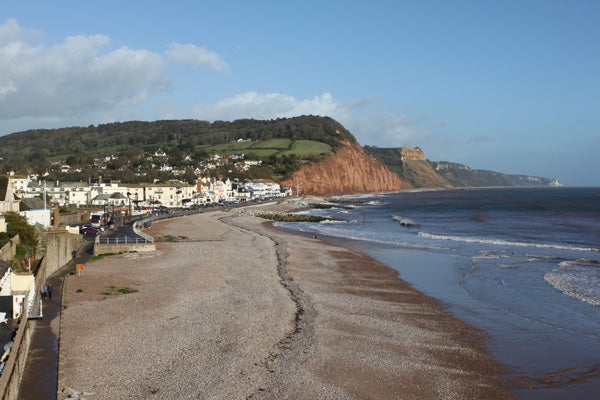
Here’s my usual DSLR test shot of Sidmouth seafront for comparison with other cameras. Click on the image to download a full-size version, but be aware that the file is nearly 7MB.
—-
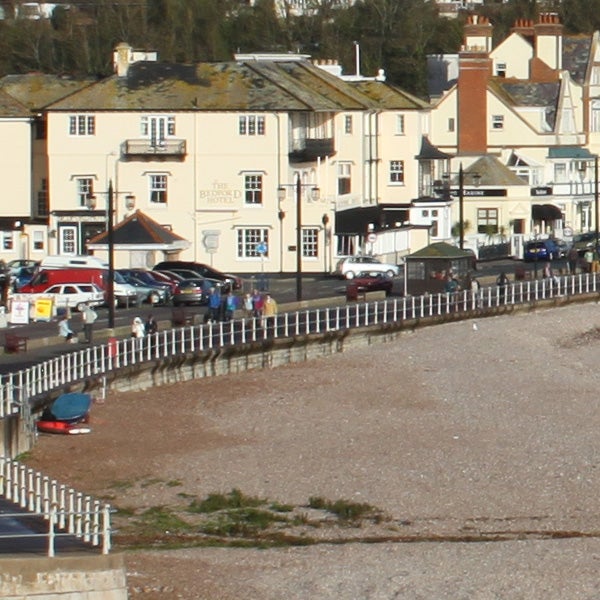
The level of detail is fantastic, but compare it with other cameras, such as the Nikon D5000 or the Panasonic GH1.
—-

This is a crop from the edge of the same photo, showing the chromatic aberration of the kit lens, even at f/11 and medium zoom.
—-
”Here are some general test shots to help evaluate the camera’s overall image quality, including dynamic range, colour rendition and the zoom range of the lens. Some pictures may be clicked to download the full size original image. ”
—-

Colour reproduction is rich and vibrant.
—-
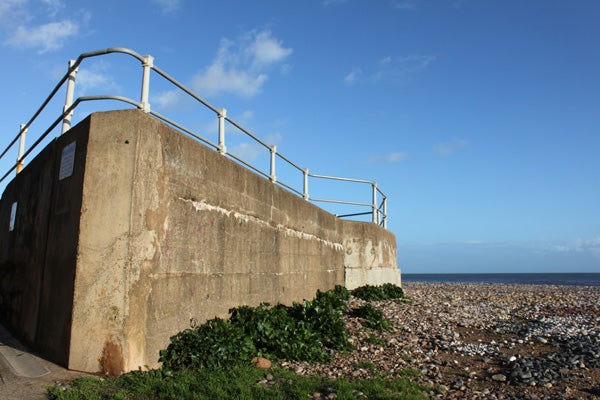
Most of the time the exposure meter is very accurate.
—-
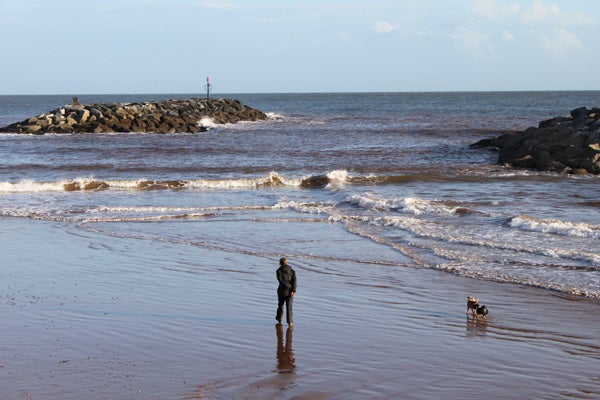
—-

In very high contrast situations the highlights are clipped and the shadows are featureless.
—-

The AF system is fast in good light, and can capture fast moving subjects.
—-
Trusted Score
Score in detail
-
Value 9
-
Image Quality 9
-
Build Quality 8
Features
| Camera type | Digital SLR |
| Megapixels (Megapixel) | 15.1 Megapixel |
| Optical Zoom (Times) | 3.1x |
| Image Sensor | CMOS |
| Image Stabilisation | Optical |
| LCD Monitor | 3 in |
| Flash modes | Auto Flash, Flash OFF, Flash ON, Red-eye Reduction |
| Video (max res/format) | 1920 x 1080 |
| Memory card slot | Secure Digital (SD) Card, Secure Digital High Capacity (SDHC) Card |

